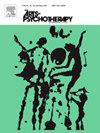艺术治疗师对时间限制艺术治疗中心问题的看法
IF 1.5
3区 心理学
Q3 PSYCHOLOGY, CLINICAL
引用次数: 0
摘要
本研究探讨了艺术治疗师在处理时间限制艺术疗法(TLAT)中心问题时的观点,TLAT是基于Mann的时间限制心理治疗(TLP; Mann, 1973)的结构化短期框架。虽然以前的研究已经注意到短期艺术治疗的好处,但这种方法的结构化概念化仍然没有得到充分的研究。该研究考察了艺术治疗师最初是如何制定的,然后是如何协同完善和参与整个TLAT的核心问题的。关注艺术创作在阐明中心问题的情感和自我相关方面,保持治疗焦点和促进变化方面的作用。本研究在一所大学的艺术治疗研究诊所进行,九名艺术治疗师进行了26次单独的TLAT治疗。数据收集包括在治疗的三个阶段(接受治疗后、治疗中期、终止治疗后)进行的半结构化访谈和由治疗师撰写的290篇过程日志。这些材料使用共识定性研究(CQR)进行分析,以确定与中心问题相关的治疗工作的关键领域,核心思想和主题。分析揭示了五个相互关联的领域:艺术在接收阶段的整合,中心问题的制定,向客户传达中心问题,中心问题在治疗期间和结束时的重要性,以及治疗在中心问题方面的意义。总的来说,在艺术创作的支持下,围绕中心问题的结构化工作似乎加深了情感探索,促进了客户的自我意识、关系成长和治疗进展。这些发现强调了TLAT作为一种动态艺术治疗方法的潜力,可以在有限的时间内优化治疗结果。本文章由计算机程序翻译,如有差异,请以英文原文为准。
Art therapists’ perspectives on working with a central issue in time-limited art therapy
This study explored art therapists' perspectives on working with the central issue in Time-Limited Art Therapy (TLAT), a structured short-term framework grounded in Mann’s Time-Limited Psychotherapy (TLP; Mann, 1973). While previous research has noted the benefits of short-term art therapy, structured conceptualizations of such approaches remain under-researched. The study examined how art therapists initially formulated and then collaboratively refined and engaged with the central issue across TLAT. Attention was given to the role of artmaking in illuminating emotional and self-related aspects of the central issue, maintaining therapeutic focus, and fostering change. This study was conducted in an art therapy research clinic in a college setting, where nine art therapists delivered 26-session individual TLAT treatments. Data collection included semi-structured interviews at three phases of therapy (post-intake, mid-therapy, post-termination) and 290 process journals written by the therapists. These materials were analyzed using Consensual Qualitative Research (CQR) to identify key domains, core ideas, and themes related to therapeutic work with the central issue. The analysis revealed five interrelated domains: the integration of art in the intake phase, formulating the central issue, delivering the central issue to the client, the significance of the central issue during therapy and at termination, and the meaning of therapy in terms of the central issue. Overall, structured work on the central issue, supported by artmaking, appeared to deepen emotional exploration and promote client self-awareness, relational growth, and therapeutic progress. These findings underscore the potential of TLAT, as a dynamic art therapy approach, to optimize outcomes within time-limited treatment.
求助全文
通过发布文献求助,成功后即可免费获取论文全文。
去求助
来源期刊

Arts in Psychotherapy
Multiple-
CiteScore
3.20
自引率
11.10%
发文量
66
期刊介绍:
The Arts in Psychotherapy is a dynamic, contemporary journal publishing evidence-based research, expert opinion, theoretical positions, and case material on a wide range of topics intersecting the fields of mental health and creative arts therapies. It is an international peer-reviewed journal publishing 5 issues annually. Papers are welcomed from researchers and practitioners in the fields of art, dance/movement, drama, music, and poetry psychotherapy, as well as expressive and creative arts therapy, neuroscience, psychiatry, education, allied health, and psychology that aim to engage high level theoretical concepts with the rigor of professional practice. The journal welcomes contributions that present new and emergent knowledge about the role of the arts in healthcare, and engage a critical discourse relevant to an international readership that can inform the development of new services and the refinement of existing policies and practices. There is no restriction on research methods and review papers are welcome. From time to time the journal publishes special issues on topics warranting a distinctive focus relevant to the stated goals and scope of the publication.
 求助内容:
求助内容: 应助结果提醒方式:
应助结果提醒方式:


